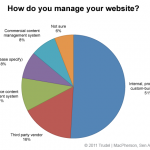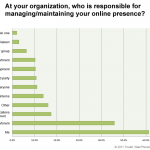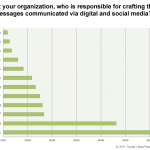How Strong is Your Social Net? 2011 Results
6. How do they manage their websites and other digital platforms?
![]() We noted that a high number of organizations reports using internal, proprietary, or custom-built solutions to manage their websites (50.9% of respondents). Proprietary systems were popular several years ago as an alternative to sometimes costly commercial website management or server software (which 8% of respondents report using) or the cost of hiring developers to build using an open source platform (10.4% of respondents). A significant number of organizations (16.4%) reported that they rely on third parties or vendors to manage their websites. Some respondents said that they weren’t sure how their websites were managed (5.9%).
We noted that a high number of organizations reports using internal, proprietary, or custom-built solutions to manage their websites (50.9% of respondents). Proprietary systems were popular several years ago as an alternative to sometimes costly commercial website management or server software (which 8% of respondents report using) or the cost of hiring developers to build using an open source platform (10.4% of respondents). A significant number of organizations (16.4%) reported that they rely on third parties or vendors to manage their websites. Some respondents said that they weren’t sure how their websites were managed (5.9%).
While open source platforms have had a reputation for being costly to build (due to the expense of hiring developers or firms to build websites using open source tools), platforms such as WordPress, Drupal, and Joomla are becoming increasingly modular and easy to use, allowing for rapid deployment and ongoing management with less reliance on vendors or technical staff. These platforms enable the easy addition of new functionality, less painful redesigns and upgrades, and content management systems that do not require extensive training or ongoing effort.
As open source software becomes more pervasive and cost effective in terms of human resources and vendor cost, we expect to see dramatic changes to these numbers. Proprietary or custom built solutions don’t age gracefully: while they may have been ideal for an organization’s needs at one point in time, they can be difficult to upgrade and customize. Commercial software is becoming less and less relevant in today’s increasingly open source world. We predict that arts organizations, and other nonprofits, will be adopting open source platforms in droves in the coming year.
![]() In terms of who is managing organizations’ online presence on the web and via social media, the picture gets murkier still. Most of our respondents were in some way directly responsible for managing digital communications within their organizations (61.2%), with lots of variations beyond that. Digital channels sometimes fall under a marketing or communications department (17.4%) sometimes under technology (6.3%), and even to interns (13.9%), since younger people have the requisite skills to work with digital tools in organizations where others may not. We predict that zones of responsibility will become clearer as digital media become more integrated with organizations’ overall communications strategy and more people become accustomed to using digital and social media (which are, in turn, becoming easier to learn and use).
In terms of who is managing organizations’ online presence on the web and via social media, the picture gets murkier still. Most of our respondents were in some way directly responsible for managing digital communications within their organizations (61.2%), with lots of variations beyond that. Digital channels sometimes fall under a marketing or communications department (17.4%) sometimes under technology (6.3%), and even to interns (13.9%), since younger people have the requisite skills to work with digital tools in organizations where others may not. We predict that zones of responsibility will become clearer as digital media become more integrated with organizations’ overall communications strategy and more people become accustomed to using digital and social media (which are, in turn, becoming easier to learn and use).
![]() Interestingly, the people responsible for the digital media were not always the ones crafting the messages, indicating complex workflows. We were talking to the right people: 65.4% of our respondents said that they were directly responsible for creating digital communications. Given that more than 50% of our respondents come from smaller arts groups (with operating budgets of less than $500,000), we conclude that many of the organizations that responded may not have a large staff, which also explains the answers we got to this question (11.7% of respondents answered “everyone”).
Interestingly, the people responsible for the digital media were not always the ones crafting the messages, indicating complex workflows. We were talking to the right people: 65.4% of our respondents said that they were directly responsible for creating digital communications. Given that more than 50% of our respondents come from smaller arts groups (with operating budgets of less than $500,000), we conclude that many of the organizations that responded may not have a large staff, which also explains the answers we got to this question (11.7% of respondents answered “everyone”).
< Previous: How are they using mobile tools? | Next: What are management’s attitudes? >
Tell us about your best/worst social media experience...
…and meet digital communications pioneers.
Click on our profile template to get started.
Want to get in touch?
We’d love to hear from you. Contact us.


